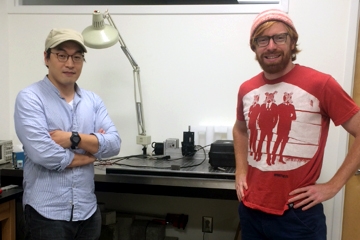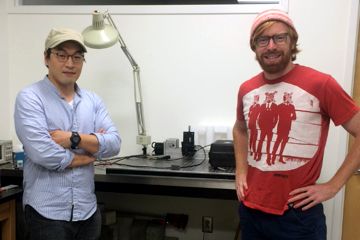
 Ph.D student Gun Kim, left, with his colleague David Torello. The journal Materials and Structures selected Kim's paper "Quantitative evaluation of carbonation in concrete using nonlinear ultrasound" as one of its 10 outstanding articles for 2015. (Photo: Gun Kim) |
The board of editors of the journal Materials and Structures has picked an article by Ph.D. student Gun Kim as one of its outstanding papers of 2015.
The research, which demonstrated a new noninvasive way to measure the carbonation of concrete, will now be available online for free as a result. In a letter to one of Kim’s advisers, Laurence Jacobs, Jason Weiss from Materials and Structures said only 10 papers earn the distinction each year.
“These papers embody the excellence of RILEM technical activities and are considered to strongly contribute to the image and visibility of our scientific community,” Weiss wrote. RILEM is The International Union of Laboratories and Experts in Construction Materials Systems and Structures, the journal’s co-publisher with Springer.
“I am pleased and humbled to receive this award,” Kim said. “I would like to acknowledge [the Electric Power Research Institute] for the financial support, and specifically I would like to thank Dr. Guimaraes and Dr. Le Pape from Oak Ridge National Laboratory. But most importantly, I would like to thank my three advisers for guiding me to pursue multidisciplinary research on the physics of nonlinear ultrasound and concrete science.”
Kim is a fourth-year doctoral student studying with Jacobs, Kimberly Kurtis and Jin-Yeon Kim. His paper outlined the group’s use of nonlinear ultrasound to quantify the carbonation in concrete, a well known reaction where calcium hydroxide reacts with carbon dioxide in the surrounding air or water to form calcium carbonate.
Kim said the calcium carbonate that forms fills pre-existing microcracks in the structure, which has two important implications.
“It can be interpreted that the durability of concrete components without reinforcement steel can be enhanced by itself due to carbonation,” he said. “Interestingly, it can be also broadly translated that carbon dioxide can be sequestered into the concrete by carbonation, meaning that the carbonation process can play a role in controlling CO2 emission into the environment.”
Kim said the ultrasound method is nondestructive and, in fact, avoids contact with the concrete altogether while still providing reliable data on the carbonation process. That means the researchers will be able to use it to assess carbonation effects in full-scale concrete structures outside a lab setting.
